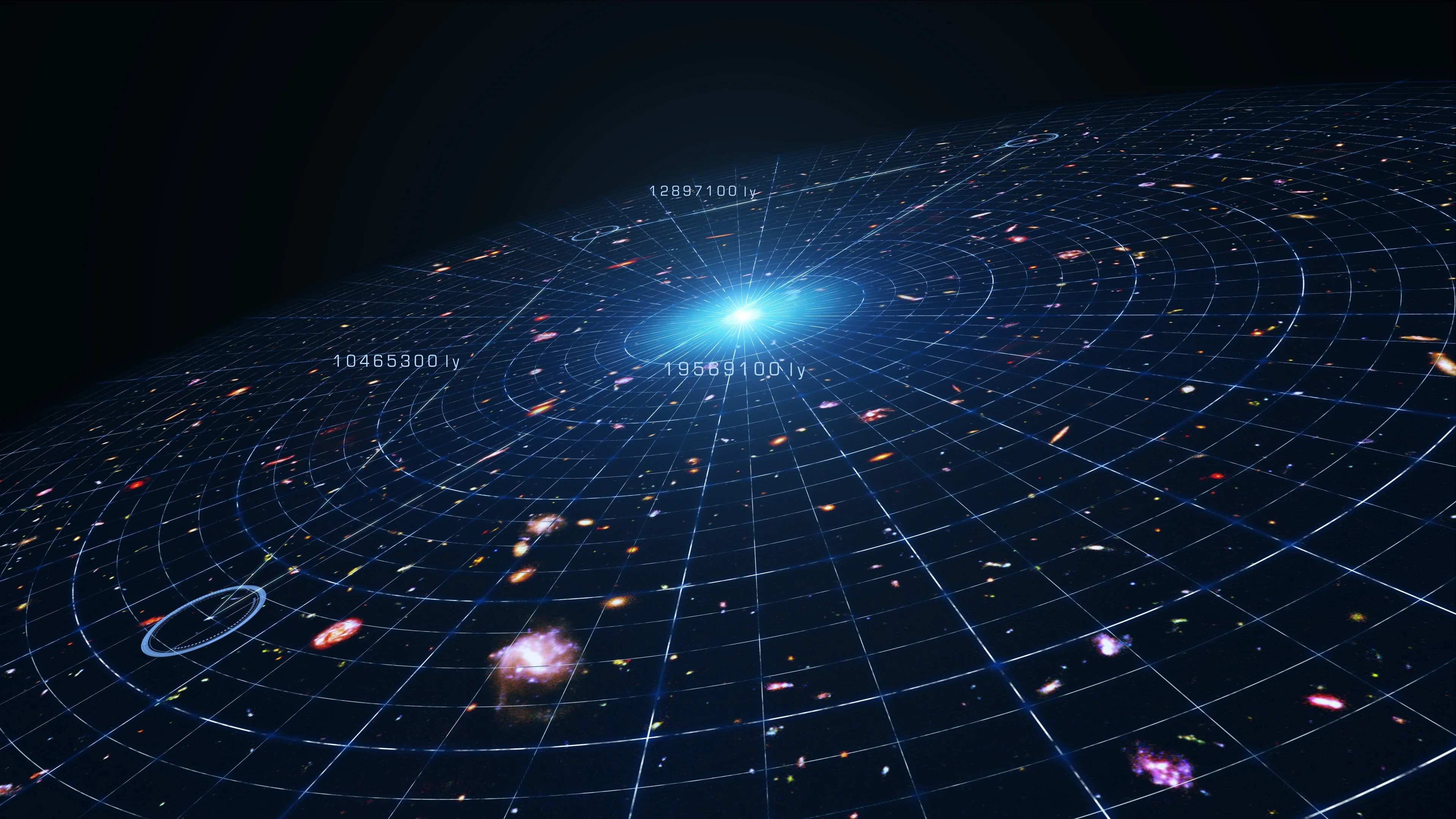

Cosmox Blogs
Hubble Lemaître Law: How We Know the Universe Expands
In 1908, Henrietta Swan Leavitt, an American astronomer, made a remarkable discovery that would set the stage twelve years later for one of the greatest debates in astronomy, starting a chain of events that would eventually reach the revered scientist, Edwin Hubble, who would bring forth ideas that would open our world to new possibilities imagined before, but only now would be reality and not science fiction.
It is about 8 p.m. on the 26th of April in the year 1920 at the Smithsonian Museum of Natural History in Washington, DC. Harlow Shapley and Heber Curtis were about to face each other with contrasting ideas regarding the ‘Scale of the Universe’. This debate would be noted in history and would make strides in the field of astronomy, only a year after Einstein had been made famous by the confirmation of general relativity's prediction for the deflection of starlight by the Sun during the total solar eclipse in May 1919.
In this article, we aim to unravel the Hubble-Lemaître law—a concept that has become foundational in modern cosmology. As described by the International Astronomical Union (IAU), the law “describes the effect by which objects in an expanding universe move away from each other with a velocity proportionally related to their distance.” We will explore the historical milestones that led to this groundbreaking idea, the core principles of the law itself, and its implications for our understanding of the universe. Starting with the historical context, we’ll journey through the crucial moments that shaped the discovery.
Part 1
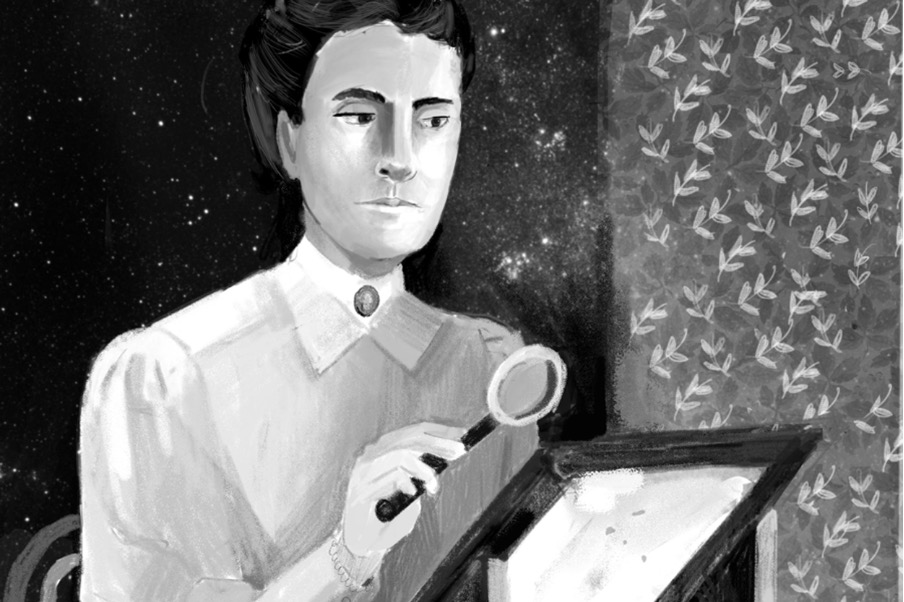
Things to know:
-> Variable Star: A star that changes in brightness as seen from Earth.
-> Cepheid Variable: A type of variable star that pulsates radially, changing size like an inflating/deflating balloon, while maintaining a spherical shape.
-> Intrinsic Brightness (Absolute Magnitude): The true brightness of a star without distance or interstellar absorption effects.
-> Apparent Magnitude: How bright a star appears from Earth, influenced by distance.
-> Standard Candle: An astronomical object with known luminosity, allowing distance calculations based on its apparent brightness.
Henrietta Swan Leavitt and the period luminosity relationship
Leavitt was an American astronomer who worked at the Harvard College Observatory, cataloging the positions and brightness of stars. During her time at work, she analyzed the relation between the periodic brightening and dimming patterns of Cepheid variables in the Small Magellanic Cloud (SMC: a dwarf galaxy that orbits the Milky Way), assuming that they were approximately the same distance from Earth. As a result, she discovered a relationship that relates a Cepheid variable star’s period of pulsation to its absolute magnitude. This relation, also known as the ‘period-luminosity relationship,’ or ‘Leavitt’s law,’ allowed astronomers to calculate the distance to these stars by comparing their apparent brightness with their intrinsic brightness.
The relation was verified using the previous, trigonometry-based method for calculating the distance to stars from Earth, the stellar parallax method. Before this relation was discovered, stellar parallax was the best method available for measuring the distance from Earth to other stars. The large distances to these other stars relative to the radius of the Earth’s orbit meant that it could only be used up to a certain distance.
Leavitt’s discovery was groundbreaking because it provided astronomers with the first standard candle in the cosmic distance ladder.
Part 2
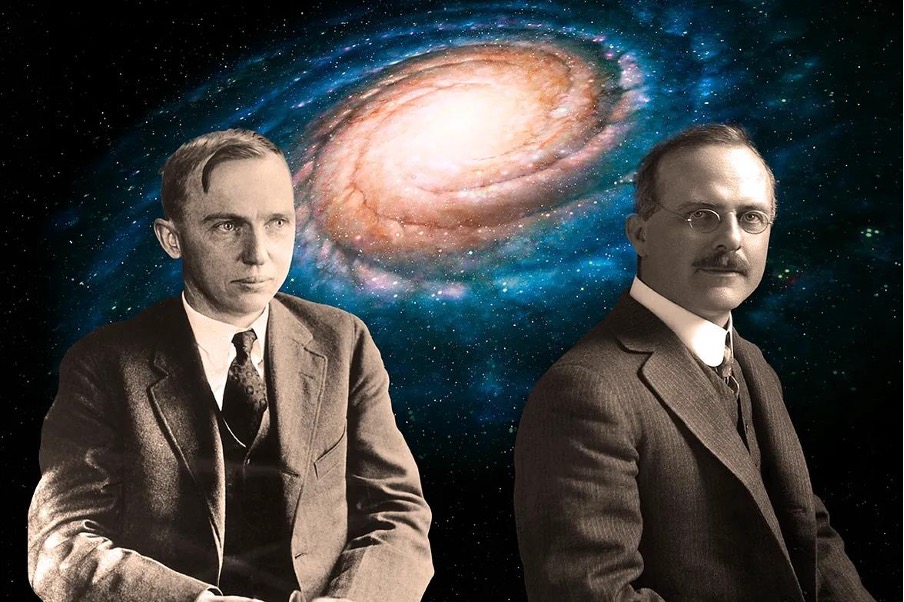 The Great Debate
The Great DebateOn 26 April 1920, the Smithsonian Museum of Natural History was the site of a debate that would change the course of astronomy. This debate, known as ‘The Great Debate’ or the ‘Shapley-Curtis Debate,’ centred on the nature and scale of the universe and brought together two prominent astronomers with contrasting views: Harlow Shapley and Heber Curtis.
Shapley argued that the Milky Way galaxy contained everything in the universe. He proposed that the spiral “nebulae” observed in the night sky, such as Andromeda, were clouds of gas within the Milky Way and not distant galaxies. His evidence included measurements suggesting the Milky Way was far larger than previously believed, with the Sun located off-centre rather than at the galaxy's heart.
Curtis, however, maintained that the spiral nebulae were “island universes”—independent galaxies situated far beyond the Milky Way. He referenced observations showing that these spiral objects had unique features that resembled smaller versions of the Milky Way, suggesting they were galaxies in their own right. Curtis also highlighted that certain novae (explosive events in stars) within Andromeda were much dimmer than those observed within the Milky Way, implying that Andromeda was indeed far more distant.
We now know that the Milky Way galaxy is not the entire universe and that the Sun is not near the centre of the galaxy. Both gentlemen had certain points that were validated and others that were not. Curtis was right about there being independent galaxies, and Shapley was right about the Sun being off-centre in the galaxy. Their exchange of technical papers and their discussion were truly a beautiful example of how ideas should be exchanged among the scientific community—with openness, respect, and a shared commitment to reach the truth.
Part 3
Things to know:
Redshift: The stretching of light to longer wavelengths as an object moves away, making it appear "redder."
Recessional velocity: The rate at which an extragalactic astronomical object recedes from an observer as a result of the expansion of the universe.
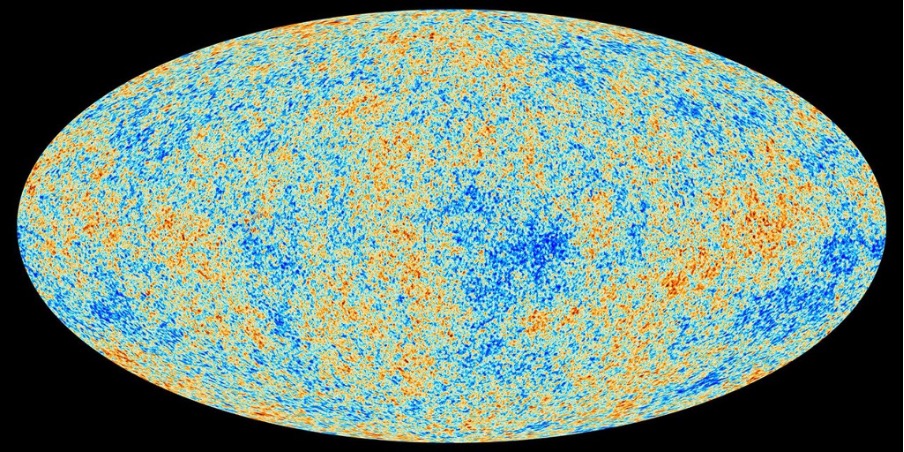
We knew the universe was expanding before Hubble’s discovery?
Partially true. Hubble’s discovery was the decisive evidence that the universe was indeed expanding. But there were already hints that pointed towards this universe before the discovery. When Einstein developed his theory of general relativity, he found that its equations didn't easily describe a static universe—a universe that is infinite in time and space and is neither expanding nor contracting. His equations implied that space itself could be dynamic—either expanding or contracting. However, Einstein had a bias. He personally believed in a static universe, so he introduced a mathematical fix called the ‘cosmological constant’ to counteract this and keep the universe stable. Without it, his equations hinted at an expanding universe.
-> In 1922, Russian physicist Alexander Friedmann found solutions to Einstein’s equations without the cosmological constant. His models described a universe that could expand or contract. Friedmann's equations laid the groundwork for an expanding universe as a real possibility.
-> Georges Lemaître, a Belgian priest and astronomer, independently arrived at a similar conclusion to Friedmann. He proposed that the universe was expanding and that distant galaxies were moving away from each other. Lemaître also connected this expansion to observed redshifts, which he theorised could indicate galaxies moving away from Earth.
-> Before Hubble, astronomer Vesto Slipher had already measured the redshifts of several “spiral nebulae” (what we now know as galaxies). Slipher found that most of these nebulae were redshifted, meaning they were moving away from us. However, at the time, the nebulae were still thought to be part of the Milky Way, so this information wasn’t interpreted as evidence of an expanding universe. (Further reading: FLRW metric)
Hubble-Lemaître law
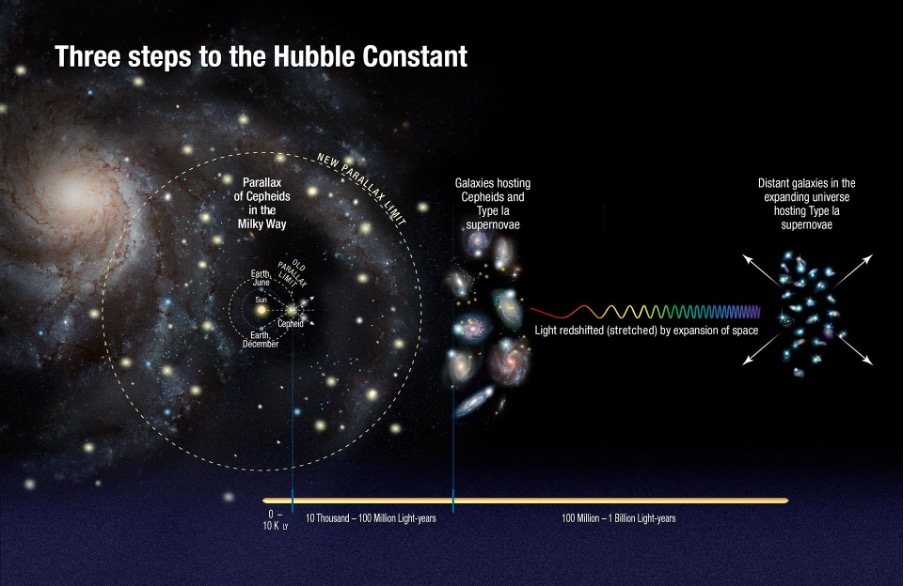
Edwin Hubble’s observations were made at the Mount Wilson Observatory, which had the most powerful telescope at the time. Hubble aimed the 100-inch Hooker telescope at the Andromeda Galaxy in 1923, and with Miss Leavitt’s period luminosity relationship, found it to be far beyond the Milky Way’s limits, confirming that. it was indeed a separate galaxy, thus proving Curtis’s point from the great debate to be true. Using his observations along with Vesto Slipher’s measurements of the redshifts associated with galaxy distances, Hubble discovered a proportionality between the redshift of an object and itsdistance, publishing the results in 1929.
Because Hubble and Lemaître reached the same conclusions independent of each other, the law is known as the Hubble-Lemaître law. It essentially states that the speed at which a galaxy recedes from us is proportional to its distance from Earth. That is to say, the farther away a galaxy is, the faster it appears to be moving away. By measuring the redshift of a galaxy, its recessional velocity can be determined. This relation is expressed as

Here, v is the recessional velocity of the galaxy, d is the distance to the galaxy, and H₀ is the Hubble constant, representing the rate of expansion of the universe.
Let us understand how this equation came to be.
The spectra of all galaxies, apart from a few very close galaxies to the Milky Way, show redshift. A plot of the recessional velocity against distance for galaxies is close to a straight line and is called a Hubble diagram. Hubble had measured the distances of galaxies using Cepheid variables within them out to distances of about 20 Mpc. (megaparsec: approximately 3.26 million light-years). He found out that galaxies with greater redshifts were also farther away. Imagine baking a sourdough bread with raisins embedded in it. When the bread expands due to heat, the distance between the raisins also increases. Similarly, in our universe, space itself is expanding, pushing galaxies away from each other. Importantly, this expansion doesn’t mean galaxies are moving ‘through’ space; rather, space itself is stretching, carrying galaxies along with it.
The constant of proportionality in this equation, the Hubble constant (H₀), is determined from the gradient of a Hubble diagram. However, accurately measuring the Hubble constant has proven challenging. Observations of the early universe (e.g., using the cosmic microwave background radiation) yield a different value for H₀ than measurements based on supernovae and Cepheid variables. This discrepancy, known as the Hubble tension, implies that we’re missing something in the cosmological model that connects these two eras. (Further reading: Nobel Prize in Physics, 2011, )
An outcome of this law is that galaxies at a certain distance might be receding away from us at speeds faster than light, implying that they might go beyond the ‘observable universe,’ i.e., beyond our ability to observe them.
Conclusion
The purpose of this article being divided into parts was not only to separate the topics due to the differences in what they present but also to show that science is a collaborative effort and every discovery builds on top of seemingly unrelated insights. With Miss Leavitt’s discovery while working as a human computer, Shapley and Curtis having a worthwhile debate, and lots of individual scientists working towards progressing our understanding of the universe, we see how the combined efforts and contributions of many lead scientific progress forward. While the nature of dark energy, theorised to drive the expansion of the universe, remains in the dark (pun intended), our knowledge about the universe is ever-growing. The universe still holds mysteries that await discovery, inspiring astronomers, scientists, students, and dreamers alike.

Cosmox Blogs
A non profit organization that works on writing and delivering blogs on cosmology, natural sciences & environment, so that people can learn more about it. We even run a forums page, where our users interacts with each other and discuss about Cosmology, Natural Sciences & Astronomy. We even run an instagram and a youtube channel with podcasts.